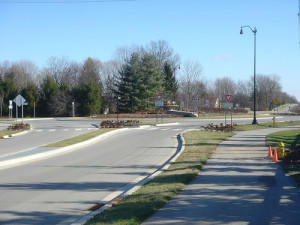
A couple days ago I referenced Pete Saunders’ observation that Sunbelt cities in their growth phase need to take advantage of their day in the sun to put in place the foundations for future next level prosperity.
I thought of this when I read a recent column by Bloomberg reporter Justin Fox. He was driving across the middle of the country. One of the suggestions I gave him was to check out Carmel, Indiana. He filed a story on their roundabouts:
"It was late one weekday afternoon in Fishers, an affluent Indianapolis suburb with a lot of offices and retail as well as houses, and the traffic was starting to get irritating. There were long waits at lights. At one intersection, the line of cars waiting to turn left blocked the main traffic lane.
Then I crossed over into Carmel, another affluent suburb with lots of offices and retail as well as houses, and everything changed. Instead of traffic lights, there was roundabout after roundabout after roundabout. There also weren’t any long waits or backups at intersections. I can’t say that I breezed through all of the roundabouts — the signage at the bigger ones was a little confusing for a first-timer — but all the other drivers seemed to know what they were doing. Traffic flowed, but it didn’t flow too fast. When a couple of pedestrians showed up at one roundabout, cars had no trouble stopping for them."
Carmel has more roundabouts than any other city in the United States, around 120 I believe. Fishers has 15 according to their web site. I’m not going to say that roundabouts are the ultimate in infrastructure, but clearly Carmel has invested heavily in its streets compared to Fishers and it shows, even to an out of town reporter from New York.
Discussion of Carmel tends to focus on its debt levels, which are very high. But the debt isn’t monolithic. I sort it into three major buckets: 1) traditional infrastructure, 2) developer subsidies, and 3) non-standard amenities.
Developer subsidies are frequently decried but are ubiquitous – even Hudson Yard in NYC got them. The non-standard amenities – like a $175 million publicly-financed concert hall – draw much of the ire.
But even if you reject all of those, a significant chunk of Carmel’s debt is for very standard, traditional infrastructure like water and streets. For example, a couple years ago the city issued a $250 million bond backed by property taxes to finance drainage improvements in older subdivisions, trails, and street improvements that include, to my count, 32 new roundabouts.
This is a lot of money to be sure – but it surfaces an important point. All the infrastructure needed to support a new suburb – streets, sewers, schools, parks, libraries, water, streets – is expensive. Frankly, when you add it all up, often it’s just plain unaffordable.
The traditional approach to this was to simply not build it. But as we discovered, in those places, as soon as the growth era is over and the houses, strip malls, etc. get old, the place quickly loses its attractiveness and abandonment and blight set in.
We’ve learned some lessons from this. Suburbs generally mandate that developers build full infrastructure in their developments now. They often charge impact fees to build parks, etc. But candidly most of them are still under-investing in infrastructure, especially streets.
Carmel, to their credit, has actually tried building out real infrastructure. I’m not even sure a wealthy suburb like them can afford to really upgrade all their streets to urban standards. But at least it’s a different strategy. Next door Fishers has done a lot with their major arterial streets. But otherwise not so much. There’s a sort of Tiebout sorting effect between these two going on right now.
In the immediate term, Carmel has better traffic than Fishers. In the longer term, we’ll have to see if Carmel’s debt creates problems vs. Fishers, or if Fishers’ unwillingness to make similar infrastructure investments ends up sending it down the same trajectory at earlier era suburbs of northern Indianapolis into decline. Both communities have over 90,000 people and buildout is not that far away for them.
This is the story that’s going to play out at the micro and macro level over time. Some places are going to find a way to assemble the political coalition necessary to make moves. Others are not. Some of those moves will work. Others won’t. As Pete showed, the cities that make the right moves are the ones that will differentiate themselves and perform over the longer term.
This piece originally appeared on Urbanophile.
Aaron M. Renn is a senior fellow at the Manhattan Institute, a contributing editor of City Journal, and an economic development columnist for Governing magazine. He focuses on ways to help America’s cities thrive in an ever more complex, competitive, globalized, and diverse twenty-first century. During Renn’s 15-year career in management and technology consulting, he was a partner at Accenture and held several technology strategy roles and directed multimillion-dollar global technology implementations. He has contributed to The Guardian, Forbes.com, and numerous other publications. Renn holds a B.S. from Indiana University, where he coauthored an early social-networking platform in 1991.












